Types of Viburnum: Shrubs, Trees and Hedges (With Pictures)
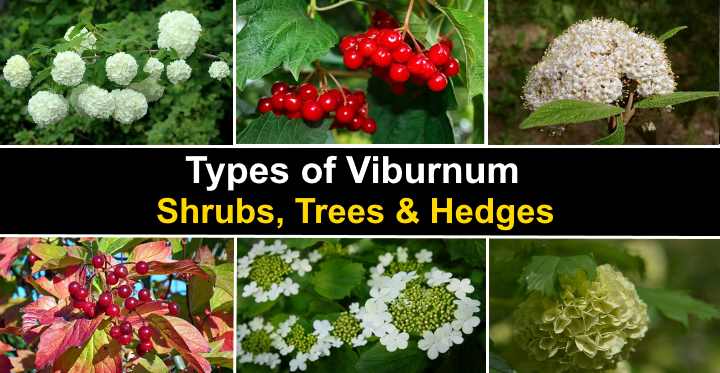
Viburnum shrubs, hedges, and trees are beautiful flowering plants that add beauty to garden landscapes. Viburnum are bushy woody plants that produce white or pinkish-white fragrant flowers that bloom throughout spring. The dark-green ovate leaves on species of viburnum turn a spectacular bright orangey-red color in the fall. One reason why types of viburnum are popular in front and backyards is that they are versatile plants that grow in most conditions.
This article is a complete guide to the most popular kinds of viburnum you can plant in your garden. Pictures of viburnum plants and descriptions of the shrubs will help identify the best viburnums for enhancing your garden’s aesthetics.
What is Viburnum?
Viburnum is a genus of shrubby plants in the family Adoxaceae. There are around 150 species of viburnum trees, shrubs, and hedge plants. Depending on the climate and species, viburnum can be evergreen or deciduous plants that thrive in full sun.
Viburnums are sun-loving flowering plants that thrive in USDA zones 4 through 8, making them ideal ornamental landscaping shrubs for temperate climates. Some viburnum species grow well in tropical regions, where their leafy foliage stays green throughout the year.
One of the identifying features of many viburnum shrubs is their horizontally tiered branching growth. Some viburnum bush types may have rounded growth, whereas other shrubs have a flat top.
Viburnum shrubs grow between 3 and 20 ft. (1 – 6 m) tall. Because of their bushy growth, viburnum plants are ideal as hedge plants, specimen plants, or mixed border shrubs. Smaller varieties of viburnum are perfect for growing in containers at entrance ways, on patios, or decks.
Viburnum Flowers
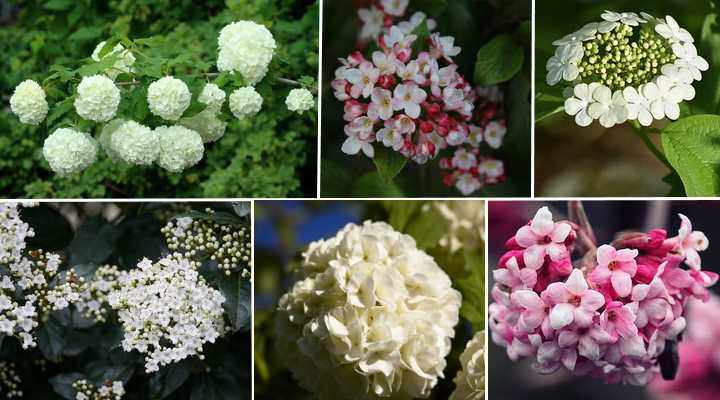
Viburnum flowers are white or pink and have different shapes, depending on the species
Viburnum flowers are made up of clusters of smaller flowers called panicles in varying white or pink shades. The flowers on viburnum bushes are usually conical, spherical, or domed shapes. When viburnum plants bloom in spring, the dense leafy bushes are transformed into beautiful bright colors. Looking at pictures of viburnum flowers, it’s easy to mistake them for hydrangea flowers.
Some viburnum shrubs flower in winter until spring. For example, the Viburnum Snowball Bush has clusters of white flowers that bloom from November until March. Laurustine (Viburnum tinus) is a winter flowering shrub with whitish-pink flowers in flat-topped clusters.
Viburnum Leaves
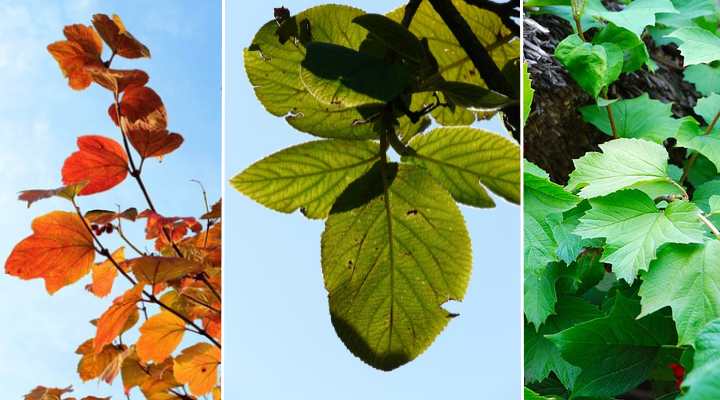
Viburnum leaves come in different shapes. On the left image: autumn foliage
Viburnum leaves come in various shapes and sizes, depending on the species. Some viburnum species such as ‘Doublefile’ and ‘Japanese Snowball’ have shiny green ovate or lanceolate leaves with serrated edges. Other viburnum shrubs, such as Viburnum acerifolium and Viburnum sargentii have leaves like maple leaves. Some varieties of viburnum, such as sweet viburnum, have glossy green leathery oval leaves.
Viburnum in the Garden
Viburnums are decorative, floral shrubs and small trees that are perfect for any size of garden. Viburnum shrubs and trees grow best in a sunny spot or in a garden area that gets partial shade. Most viburnum varieties need to grow in well-draining, moist soil and flourish in clay, chalk, loamy, or sandy soil.
Viburnum Berries
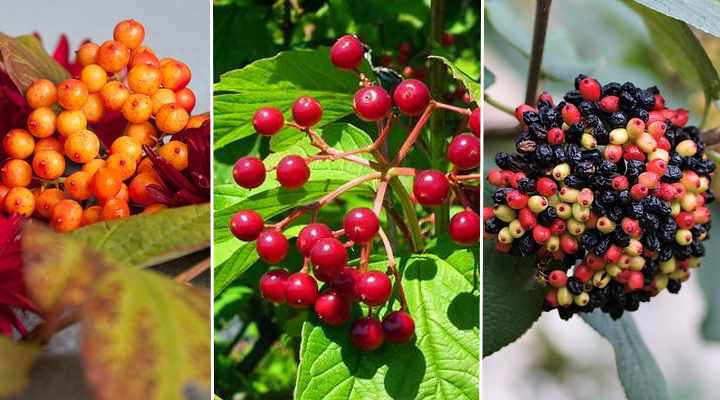
Viburnums have berry-like fruits that vary in color
Viburnum berries grow in densely-packed clusters of small round colorful fruits, which are actually tiny drupes. As the “berries” ripen on the shrub, they change color. Ripened viburnum berries can be bright red, deep purple-black, blue, neon-pink, or bright yellow. Many varieties of viburnum shrubs produce edible berries. However, some types of viburnum berries are mildly poisonous.
For example, the cranberry bush viburnum (Viburnum opulus var. americanum) produces ornamental red berries clusters. The scarlet-red berries contrast nicely with the lush green shiny foliage. These edible berries are used to make jams and jellies, and they also attract birds to gardens.
Viburnum Hedge
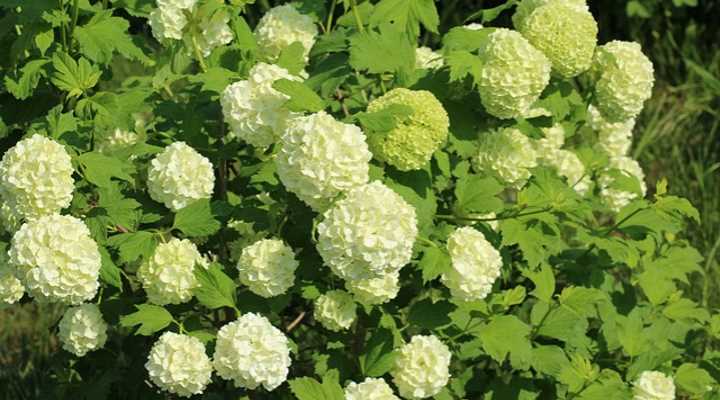
Viburnum shrubs can be grown as privacy screens and flowering hedges
Viburnum hedge plants create lush, dense privacy screens that produce fragrant spring flowers. Viburnum hedging is ideal for formal or informal hedges, depending on how much you want to prune the shrub.
The best varieties of viburnum for hedging are Sweet Viburnum (Viburnum odoratissimum) for full sun, Sandankwa Viburnum (Viburnum suspensum) for shade, Laurustine (Viburnum tinus), and Chindo viburnum (Viburnum awabuki ‘Chindo’).
To choose the best viburnum hedge plant, it’s good to know the differences between varieties. For example, Sweet Viburnum grows faster than Viburnum tinus. However, Viburnum tinus is an easier-to-care-for shrub and smaller hedge plant than Sweet Viburnum.
Viburnum Tree
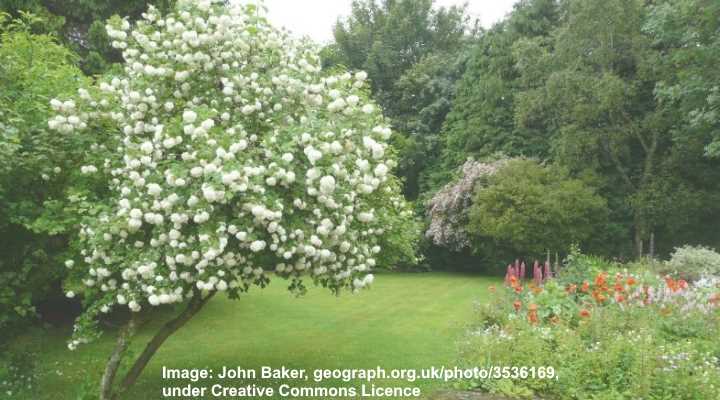
A picture of Viburnum opulus ‘Sterile’ pruned as a multi-stem tree
Large viburnum multi-stemmed shrubs can grow as small flowering trees in your garden landscape. Some large viburnum shrubs need regular pruning to make them grow into small trees. Some varieties of viburnum are ideal for tall privacy hedges or screening. Some of the best types of large viburnum shrubs that grow as trees are Snowball tree (Viburnum opulus), Blackhaw Viburnum (Viburnum prunifolium), and Leatherleaf viburnum (Viburnum rhytidophyllum).
Dwarf Types of Viburnum
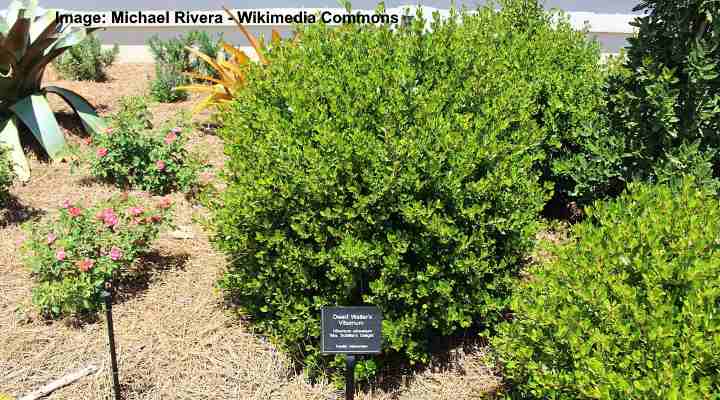
Dwarf Walter’s Viburnum obovatum
Dwarf viburnum varieties are perfect for small, compact residential gardens. Dwarf viburnum shrubs grow between 1 and 5 ft. (0.3 – 1.5 m) tall. Popular examples of dwarf viburnum bushes include the Viburnum carlesii ‘Compactum,’ dwarf European cranberrybush viburnum, and dwarf Viburnum obovatum.
Like the larger varieties, miniature, compact viburnum bushes have plenty of all-season interest—spring flowers, dense leafy summer foliage, stunning fall colors, and clusters of berry-like fruits. Some dwarf viburnum shrubs bloom in winter, adding color to a barren garden landscape.
Types of Viburnum (With Pictures)
Viburnums are attractive flowering shrubs that add beauty to any garden. Let’s look at some popular types of viburnum shrubs and trees that you can grow in your front or backyard.
Sweet Viburnum (Viburnum odoratissimum)
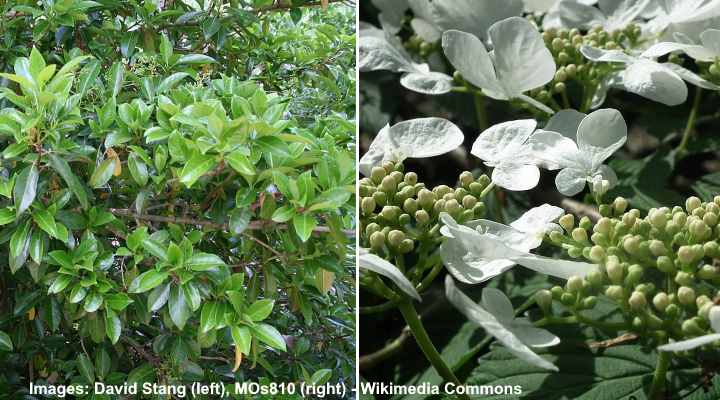
Sweet viburnum has clusters of white flowers and can be grown as a hedge plant or a large shrub
Sweet viburnum is a sizeable shrubby plant with clusters of small white flowers that give off a delightful scent. When in full bloom, you’ll notice that the white flower clusters grow in a conical shape. Sweet viburnum has large, dark green glossy green leaves in an ovate shape. The green shrub’s leaves grow up to 6” (15 cm) long and wide.
Sweet viburnum is a slow-growing variety of viburnum that grows well as a small shrubby tree or tall evergreen privacy hedge. Sweet viburnum will grow up to 20 ft. (6 m) tall and wide. In northern climates, the shrub’s foliage is semi-evergreen or deciduous. The dense foliage creates a rounded crown with its spreading growth habit.
Sweet viburnum berries are red as they ripen and gradually turn black when fully ripe.
Mapleleaf Viburnum (Viburnum acerifolium)
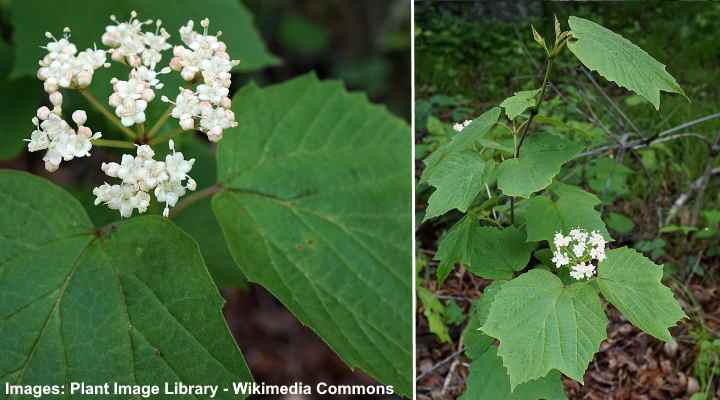
Mapleleaf viburnum is a small shrub with white flowers and foliage that is similar to maple leaves
Mapleleaf viburnum is a deciduous shrub with lobed green leaves and clusters of ornamental white flowers that bloom in spring. This viburnum species is a garden favorite due to its year-long seasonal interest. The bright green, maple-like leaves decorate gardens in summer before turning orange, pink, or purple in the fall.
Mapleleaf viburnums are small shrubs that grow between 4 and 6 ft. (1.6 – 1.8 m). Like most viburnum species, the maple leaf variety thrives in full sun, well-draining soil, and USDA zones 4 through 8.
The interesting feature of maple leaf viburnum shrubs is their ovate leaves with three lobes. Looking at pictures of the leaves, you will see the resemblance to maple leaves. The pale green leaves have some hairs and serrated margins.
Mapleleaf viburnum flowers grow in the shape of tubular clusters. Tiny creamy-white flowers make up the fragrant panicles when they bloom from April to June. The showy flat-topped clusters measure about 3” (7.5 cm) across. After blooming, black berries appear on the shrub and last until winter.
Sandankwa Viburnum (Viburnum suspensum)
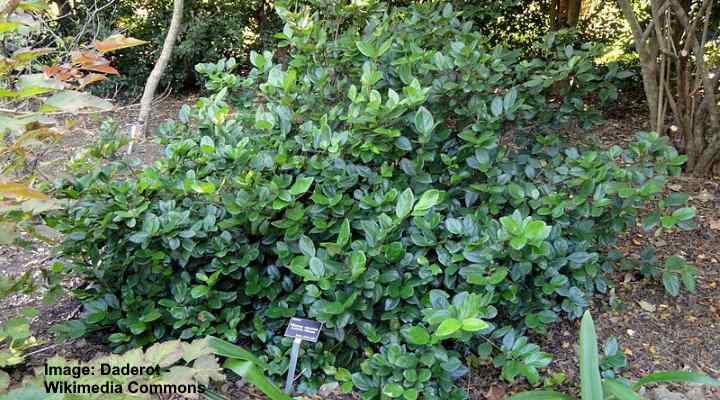
Sandankwa viburnum shrub has spreading growth habit and is suitable to grow as a hedge
Sandankwa viburnum is an evergreen perennial shrub in warm climates such as Florida. Pinkish-white flowers appear on the shrub when it’s in bloom in late winter and early spring. The clusters are made up of tubular white-pink flower panicles. Sandankwa ovate-shaped green leaves are rough and leathery.
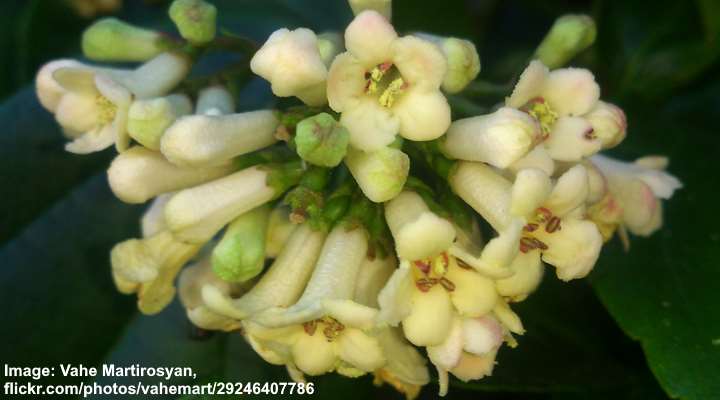
Sandankwa viburnum flowers are white to pale pink
Sandankwa viburnum grows up to 12 ft. (3.7 m) high. The fast-growing shrub has a spreading nature with horizontally growing branches covered in dense foliage. This compact evergreen shrub is cold hardy in USDA zones 8 through 11.
Due to its dense, glossy foliage, Sandankwa viburnum grows best as a privacy hedge or large border shrub.
Viburnum Awabuki ‘Chindo’ (Chindo Viburnum)
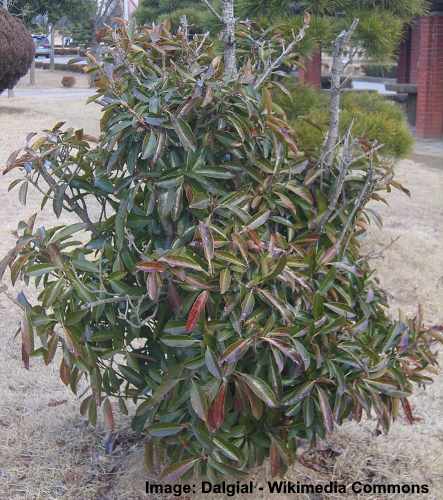
Chindo viburnum is a low maintenance fast growing bush with evergreen foliage
‘Chindo’ viburnum is a large woody shrub that blooms in spring with showy, fragrant white flowers. The white tube-like flowers grow in small clusters or panicles. Adding to the landscaping shrub’s attractiveness are glossy, leathery leaves that have a waxy feel. Leaves measure 6” (15 cm) and 3” (7.5 cm) wide.
Also called mirror leaf viburnum, the ‘Chindo’ shrub grows between 10 and 12 ft. (3 – 3.6 m) tall. ‘Chindo’ viburnum also has a fast growth habit, and its densely growing crown forms a pyramidal shape. Like all varieties of viburnum, the ‘Chindo’ variety requires little maintenance to keep its shape.
Awabuki viburnum plants are ideal for hedging in front or backyards. The plant’s evergreen shiny foliage provides plenty of privacy in all seasons. Because this is a drought-tolerant variety of plant that requires little pruning, this hedge plant grows with little fuss.
Viburnum Snowball Bush (Viburnum opulus ‘Roseum’ or ‘Sterile’)

Viburnum snowball bush has showy round white flowers and can be pruned as a small tree
The ‘Snowball Bush’ viburnum is also called the European Cranberry bush. This large viburnum species is a shrub with a rounded growth habit. The outstanding feature of the Viburnum opulus is its large snowball-shaped white flowers. The round flower blossoms contrast with the green maple-like leaves. In fall, the shrubby plant turns warm shades of orange and red.
The Snowball Bush viburnum grows between 10 and 12 ft. (3 – 3.6 m). The European Cranberry bush is also an excellent specimen to grow a viburnum tree. Therefore, the plant is sometimes called the Snowball tree or European Cranberry tree.
The Viburnum opulus ‘Nanum’ is a dwarf viburnum that doesn’t grow taller than 2 ft. (0.6 m). You can also use this ornamental flowering dwarf shrub as a beautiful foundation plant for the front of your house.
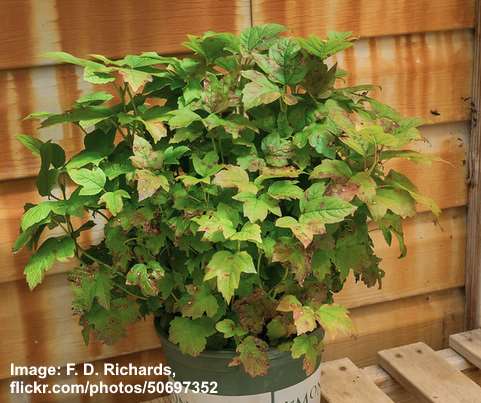
Viburnum opulus ‘Nanum’ is a dwarf type of viburnum
Blackhaw Viburnum (Viburnum prunifolium)
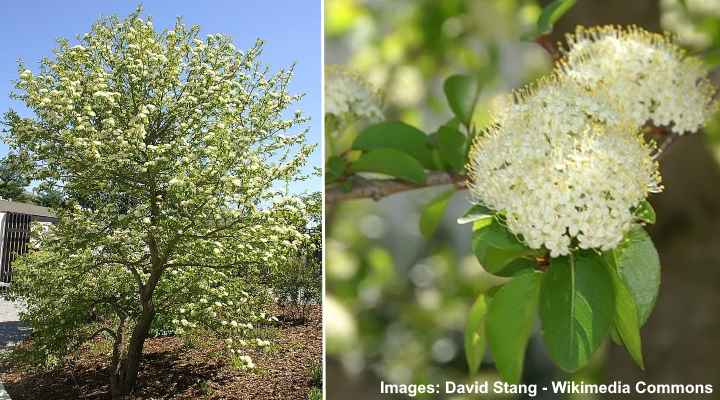
Blackhaw viburnum can be grown as a large flowering shrub or a small tree
Blackhaw viburnum is a small tree with dense foliage, masses of white flower clusters, and stunning fall foliage. Apart from the beautiful white flower blooms in May and June, the ornamental dark green foliage and red-burgundy fall colors extend the plant’s seasonal interest. Also, pendulous black edible berry-like fruits add to the shrub’s appealing qualities.
Blackhaw viburnum trees grow around 15 ft. (4.5 m) tall with a spread of 12 ft. (3.6 m). With proper pruning, you can also grow this multi-stemmed plant as a large shrub, privacy screen, or hedge plant.
Korean Spice Viburnum (Viburnum carlesii)

Korean Spice viburnum is a small shrub with attractive pinkish-white flowers
Korean spice viburnum is a deciduous shrub with pinkish snowball blooms, bright red berries, and dark red fall leaves. Clusters of delicate flowers form spectacular globe-shaped flower heads. You’ll notice that pictures of these viburnum whitish-pink flowers show that they resemble the look of cherry blossom trees. The broad-leafed shrub has ovate-shaped leaves.
Korean spicebush is a slow-growing shrub that grows one to two feet per year. The shrub’s mature height is about 6 ft. (1.8 m). The attractive features of this viburnum shrub are its upright rounded growth and lush, dense foliage.
Korean spicebush viburnum grows best as a specimen plant, informal hedge, foundation planting, or perennial border.
Leatherleaf Viburnum (Viburnum rhytidophyllum)
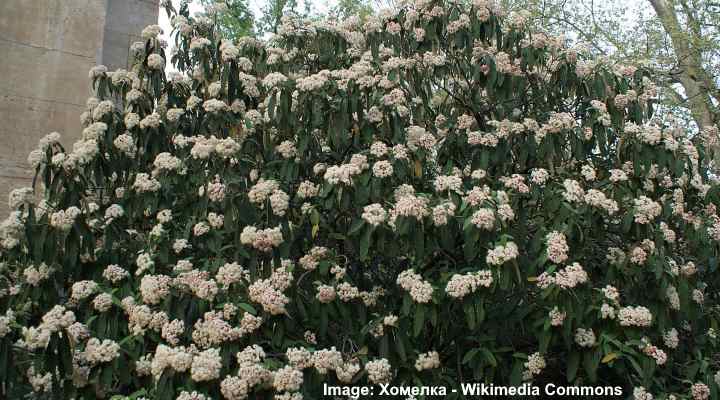
Leatherleaf viburnum is an evergreen shrub with white flowers and decorative crinkled leaves
Leatherleaf viburnum is an evergreen shrub that blooms in late spring with showy white flowers growing in domed clusters. The multi-stemmed shrub has long lance-shaped glossy-green leaves. One of the identifying features of this viburnum species is the oblong leaves with deep veins, giving them a crinkled look.

Close up pictures of Leatherleaf viburnum flowers and leaves
Leatherleaf viburnum shrubs grow between 6 and 10 ft. (1.8 – 3 m) tall. Its seasonal interest comes from the showy white flowers, clusters of bright red berries that turn black by winter, and orangey-red fall foliage.
Arrowwood Viburnum (Viburnum dentatum)
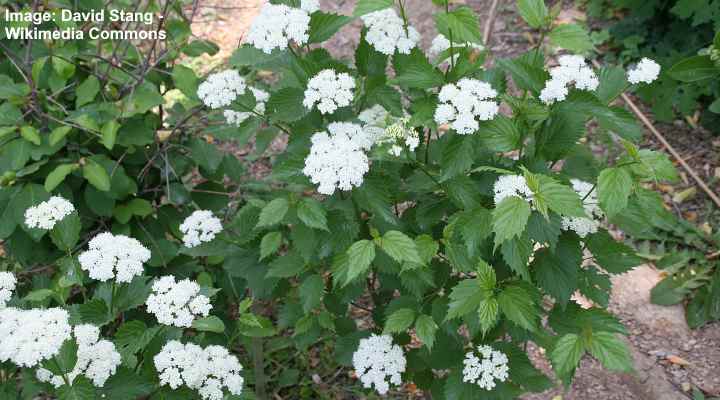
Arrowwood viburnum is a wide-spread bush with clusters of white flowers and toothed edged leaves
Arrowwood viburnum is a sizeable hardy shrub that produces white flower clusters in late spring. This viburnum species has an irregular, rounded shape and spreading growth, making it ideal for hedgerows. Arrowwood leaves are shiny green with coarsely toothed edges. In fall, the large viburnum shrub turns a red or purple-red color.
Arrowwood viburnum shrubs grow between 6 and 15 ft. (1.8 – 4.5 m) tall with a wide spread of similar size. Grow this species in full sun or partial shade in well-draining soil that is kept moist.
David Viburnum (Viburnum davidii)

The ornamental small David viburnum shrub has creamy pink flowers and dark foliage
David viburnum is a compact shrub that grows between 3 and 5 ft. (1 – 1.5 m) tall. The ornamental value of this landscaping shrub is from its clusters of creamy pink, star-shaped flowers. The stunning bluish-green leaves on the David viburnum are ovate-shaped with a leathery feel. In the fall, leaves turn deep red or orange, and clusters of edible blue or black berries last until winter.
Laurustine (Viburnum tinus)
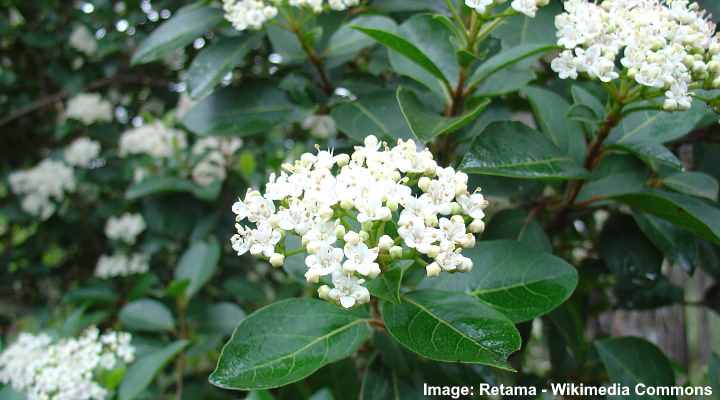
Laurustine is a viburnum shrub with a dense, rounded growth habit and evergreen foliage
Laurustine is an ornamental bushy viburnum shrub that has stunning white flower clusters and metallic blue berries. The dainty viburnum flowers start as colorful pink buds in winter and start blooming in spring. The white flowers contrast with ovate, glossy green leaves. Laurustine grows up to 8 ft. (2.4 m) tall. This viburnum shrub grows best as a flowering hedge, evergreen screen, foundation planting, or colorful shrub border.
Japanese Snowball Bush (Viburnum plicatum)
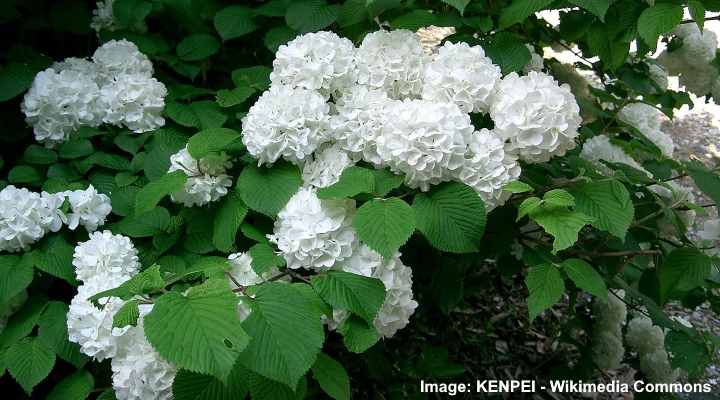
Japanese Snowball bush (Viburnum plicatum var. Plicatum)
Japanese snowball bush viburnum is a large shrub with pompom showy white flowers made up from ruffled petals. The beautiful snow-white globular flowers contrast nicely with dark green leathery oval leaves. These viburnum shrubs grow up to 10 ft. (3 m) tall.
Planting Viburnum Flowering Shrub
Viburnum shrubs are versatile landscaping plants that add color to the garden throughout all seasons. Viburnum plants have excellent spreading growth, and you should plant them in a location where they have enough space to grow. Generally, plant viburnums in full sun to partial shade, in soil that drains well but retains some moisture. Viburnum shrubs thrive in most soil types—loam, sand, clay, and chalk.
To plant viburnum flowering shrubs as hedging, choose Sweet Viburnum (Viburnum odoratissimum) or Laurustine (Viburnum tinus) for full sun or Sandankwa Viburnum (Viburnum suspensum) for shade. To work out how far apart to space the shrubs, divide the mature width by two. For example, sweet viburnum hedge plants have a spread of around 6 ft. (2 m). So, it would be best if you planted this viburnum variety about 3 ft. (1 m) apart.
How to Care for Viburnum
To care for viburnum shrubs, make sure that the plants get enough water during dry periods. You should also add a layer of mulch around the thick stems to lock in moisture. Prune the branches in early spring to shape the bush and remove dead and diseased branches.
Related articles:
- 21 Evergreen Shrubs for Front or Backyard
- Types of Red Berries That Grow on Trees or Shrubs
- Small or Dwarf Flowering Shrubs
